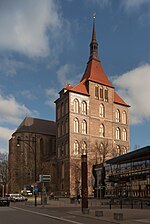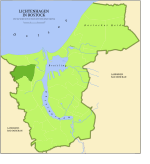Michaeliskloster

Michaeliskloster is a monastery building in Rostock, Mecklenburg-Vorpommern, Germany. It was a home to the Brethren of the Common Life, and hosted major printing and bookbinding of the late Middle Ages. In April 1942, after British bombing raid completely burned the monastery, it was in ruins. The eastern section was restored in the 1950s and the United Methodist congregation transferred to it. The historic exterior back of the west wing was retrofitted in 1994 with reproduced form bricks and other special-sized bricks which were adapted to the character and physical properties of the original bricks. In the present day, the University of Rostock Library houses its special collections in Michaeliskloster.
Excerpt from the Wikipedia article Michaeliskloster (License: CC BY-SA 3.0, Authors, Images).Michaeliskloster
Altbettelmönchstraße, Rostock Stadtmitte (Ortsbeirat 14 : Stadtmitte)
Geographical coordinates (GPS) Address External links Nearby Places Show on map
Geographical coordinates (GPS)
| Latitude | Longitude |
|---|---|
| N 54.0871 ° | E 12.1362 ° |
Address
Altbettelmönchstraße 4
18055 Rostock, Stadtmitte (Ortsbeirat 14 : Stadtmitte)
Mecklenburg-Vorpommern, Germany
Open on Google Maps











